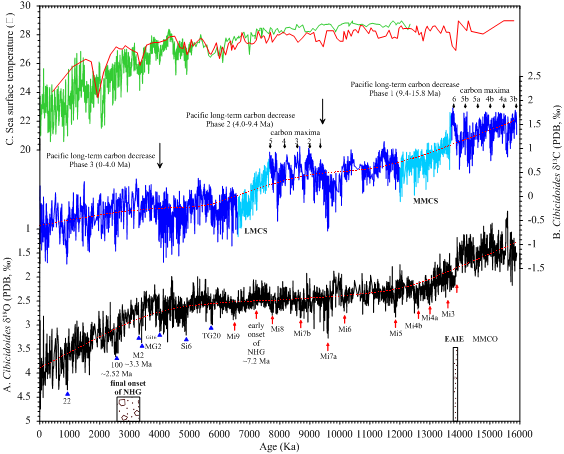Jun Tiana,∗, Xiaolin Maa, Jianhong Zhoua, Xiaoying Jianga, Mitch Lyleb, Julia Shackfordc, Roy Wilkensd
a State Key Laboratory of Marine Geology, Tongji University, Shanghai 200092, China
b College of Earth, Ocean, and Atmospheric Sciences, Oregon State University, 104 CEOAS Admin Bldg., Corvallis, OR 97331, United States
c Department of Oceanography, Texas A&M University, TAMU 3146, College Station, TX 77840-3146, United States
d Hawaii Institute of Geophysics and Planetology, University of Hawaii at Manoa, 1680 East West Road, Honolulu HI 96822, United States
Abstract:
We present astronomically tuned high resolution (~3-4 Kyr) 15.8-Myr long benthic foraminiferal d18O and d13C records from IODP Site U1337 in the east equatorial Pacific, which provide a reference standard for stratigraphic correlation of deep sea sediments. A long-term glaciation history over the past 15.8 Myr has been recorded in the d18O. Two of the most significant glaciation events include the East Antarctic Ice Sheet expansion (EAIE) at 13.8 Ma and the final onset of the Northern Hemisphere Glaciation (NHG) in 3.3-2.5 Ma. A series of Miocene and Pliocene glaciation events exist between the EAIE and NHG, which are important glaciation attempts before the Earth finally entered the full “icehouse” world in the late Pleistocene. A long-term ocean carbon isotope decrease over the past 15.8 Myr has been recorded in the d13C. Ocean circulation change was the major cause of the ocean carbon isotope decrease in 9.4-8.1 Ma and 4-0 Ma, whereas strengthened continental chemical weathering controlled the long-term ocean carbon isotope decrease in most of the time of the past 15.8 Myr.The divergence in benthic foraminiferal d13C and eNd provides strong evidence of significant ocean circulation change between 12.1 and 9.2 Ma which was probably related to the formation of the Isthmus of Panama. The internal feedbacks such as continental weathering and sea surface temperature change have great potential for modulating the weak 100 and 400 Kyr signals in astronomical forcing into strong 100 and 400 Kyr signals in global ice volume and carbon cycle.

Full article:https://www.sciencedirect.com/science/article/pii/S0012821X1830431X


